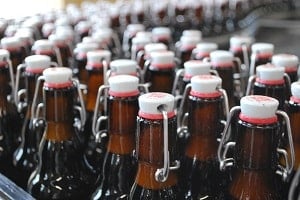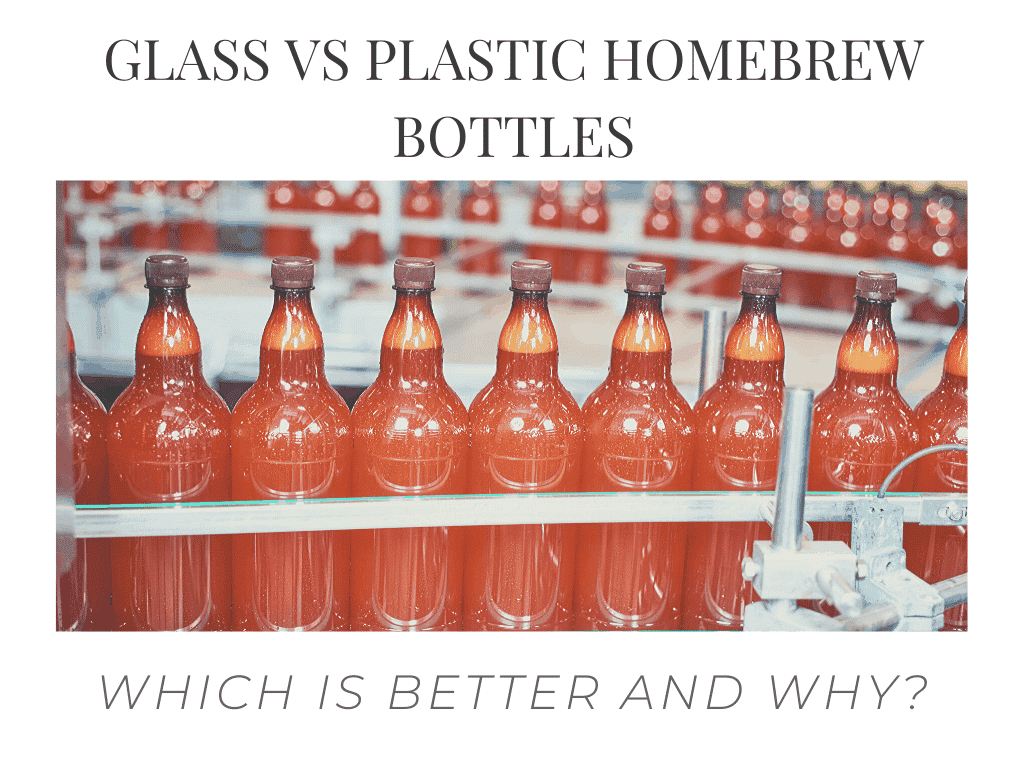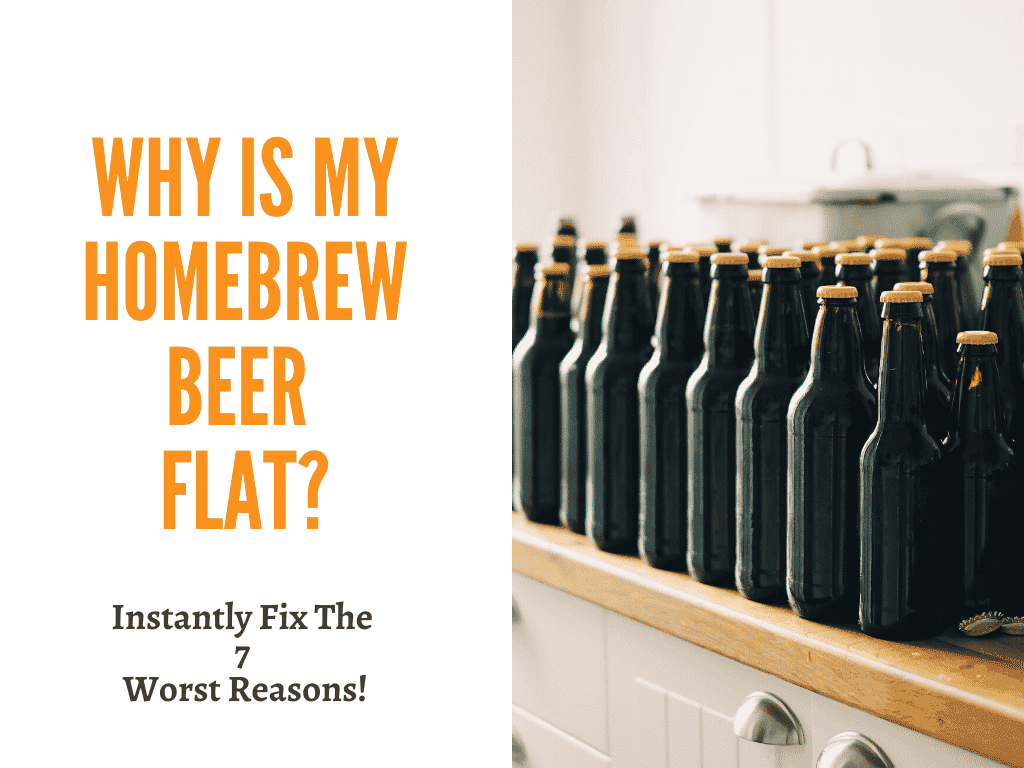You saw bubbles in the airlock and know your beer is carbonated, but now that you’re pouring it (whether from a bottle or keg), there’s no head. What is happening, and what can a homebrewer do both to save this batch and prevent no-head beers in the future?
A lack of head on your homebrewed beer can be caused by low protein content in the beer, improperly cleaned equipment or glassware, or not enough carbonation. These issues can be present in both bottled and kegged beer. To improve your beer’s head, check the beer temperature, allow your bottles to sit in a warmer space, and check your lines.
Continue reading for more on why there is no head on your beer, how to fix the beer you already have, and what you can do to ensure your beer has a thick, frothy head next time.
Topics We Cover
Why does your homebrew have no head?
The head of a beer is made up of proteins and carbon dioxide and serves as a protective layer for the beer underneath.
A protein specific to barley malt is hydrophobic, which means it clings to CO2 bubbles as they rise to the beer’s surface, providing a protective skin around the bubbles that makes them more difficult to pop. Because of this protein reaction, beer is the only alcoholic beverage that forms and maintains a head.
The head also adds texture and aromas that aren’t present in the beer itself. So when your homebrew doesn’t have that foam, you’re missing out on a big part of the beer-drinking experience.
Starting on brew day and all the way up to when you’re pouring yourself a glass of your beer, there are a handful of reasons the beer isn’t foaming:
- Your equipment wasn’t cleaned properly – Residual oils, detergents, and fragrances (like those found in regular dish soap or dishwasher detergent) can all cause off-flavors in beer and prevent a head from forming.
- The ingredients you used – Adding high-fat and/or low-protein adjuncts like corn, rice, coffee, or chocolate can have a detrimental effect on the head of your beer. They interrupt the process necessary to form that protective layer around CO2 bubbles as they rise.
- …and the ingredients you left out – Skipping ingredients that contribute to head retention such as flaked barley, bittering hops, or dextrin malts like Carapils reduces the likelihood and strength of foam formation.
- Your beer is under-carbonated – If there isn’t enough CO2 for the proteins to hitch a ride to the surface of the beer, then a head isn’t going to be able to form.
- Problems with glassware – Any oils, detergents, or fats can have a negative effect on head retention. The shape of the glass can also determine the head formation (or lack thereof).
Beer pours out of a bottle with no head
While any of the above reasons could contribute to no head to your beer, there are also factors unique to bottled beer that could contribute to a lack of head.
It could be as simple as improperly pouring the beer.
A steep tilt with a slow, gentle pour does not allow the CO2 to be released. A vigorous pour – starting the glass at a 45-degree angle and then tilting it upright when the beer reaches the halfway point of the glass – ensures the release of CO2 bubbles so they can form a thick, attractive head.
Note that it’s a ‘vigorous’ pour and not an ‘aggressive’ one; you don’t want to end up with beer everywhere but in your glass!
If you have the tilt mastered and still there’s no head, it may be that your bottles are being stored too cold. If you aren’t getting the carbonation you were expecting after a couple of weeks of bottle conditioning, move the bottles to a warmer area of your house, like a room that stays above 70℉.
You’ll have to open up a bottle to check on progress periodically, and once it’s reached the level of carbonation you’re happy with, you can move the bottles to a cooler room or straight to the fridge.
No head on beer from kegged homebrew
Just as there are issues specific to bottled beer, kegged beer can also experience a total lack of head.
Similar to how a gentle pour from a bottle results in no head in the glass, if your line is too long or too thin, the CO2 will be so slowed down that it won’t be able to form a head once in the glass. You can remedy this by using a wider and/or shorter hose.
Also, like bottled beer, if your kegged beer is too cold, it will not pour out with great head. The ideal temperature for kegs is 38℉.
Another culprit could be a gas leak. Check out this guide for determining whether your system has a leak and how to fix it depending on where the leak is located.
Beer head disappears quickly
As discussed above, fats, oils, and residue are the enemy of proper head formation.
If the beer forms a head when poured but then loses it quickly, it’s likely due to an improperly cleaned glass.
It’s also possible that waxy lipstick or gloss could kill the suds. Hopefully, it’s only coming into contact with your beer because you’re the one wearing the makeup and not because it was leftover on the glass from a previous drinker (ew!).
How long should beer head last?
There are a couple of factors that determine how long a beer head can last.
Nitro beers can still have a creamy head until the glass is drained. The finer bubbles produced by the nature of nitro’s lower solubility lead to a head that can last and last, whereas CO2 bubbles aren’t as smooth. This means a rockier foam formation, but that doesn’t mean a thick head can’t be achieved with CO2.
Thicker heads will last longer than thinner, less stable heads, so using a glass that is clean and appropriate for the style of beer you’re drinking will contribute to the life of your head.
Ideally, the head will last for the majority of your drinking experience, but if you’re eating greasy food while you enjoy your beer or drinking outside on a hot day, you may get less time with the suds than you would under more foam-friendly conditions.
How to fix a homebrew that has no head
If your homebrew beer has no head, start with the immediately easy fixes and move backward.
To troubleshoot homebrew with no head:
- Double-check the cleanliness of your glasses and then pour, whether from a bottle or keg, using the vigorous method detailed above.
- Evaluate the temperature of your beer and adjust.
- Give your bottles a few more days in a warmer space. Check periodically for improvement.
- Check your lines for resistance and look for gas leaks.
How to prevent your homebrew from having no head next time
So now that you’ve gone through one batch of beer that had no head and did all the detective work to determine where you went wrong, you definitely don’t want to go through all that again!
There are ways to prevent foamless beer in the future, and most of them begin on brew day:
- Clean and sanitize properly
- Adjust your mash schedule
- Use heading agents
- Watch your temperature
- Use clean glassware that is appropriate to the style of beer
Clean and sanitize properly
There’s a difference between cleaning, sanitizing, and disinfecting. You’ll want to use chemicals and techniques specific to homebrewing to ensure you get the best beer (and head!) possible.
This extends to your bottles, so ensure they are free of debris, oil, or fragrances from soaps.
Adjust your mash schedule
Proteins are the real heroes to head formation and retention, so you’ll want to do what you can to treat them right.
Higher mash temperatures, about 155-160℉, will result in a fuller-bodied beer with better head retention in most cases.
Use heading agents
Ingredients like flaked barley and dextrin malts provide proteins necessary to enhance beer head. Carapils, for instance, can enhance foam with little impact on flavor, whereas flaked barley adds body and foam retention properties without adding fermentable sugars.
Keep a bag of either handy in case you’re concerned about the protein content of a batch. A small addition can help offset low-protein ingredients you’d like to add for different flavors, like corn, rice, spices, chocolate, or coffee.
In addition, bittering hops provide isohumulone, alpha acids that increase foam. These alpha acids naturally repel water, which we earlier found is important in CO2 bubble formation.
Watch your temperature
Whether your beer is bottled or kegged, it (and the potential for great head retention) is susceptible to the temperature. Keep bottles cold once you’re certain they’re conditioned, and keep kegs around 38℉.
Use clean and appropriate glassware
Using a glass that is completely cleaned of any oils, fats, or other substances that get in the way of head formation is half the battle.
In addition, choose glassware that is meant for enhanced foam, such as tall, narrow glasses. The small mouth of these kinds of glasses means there is less surface area from which bubbles can escape, so instead, they’ll build. You will end up with a thicker, more stable head since the bubbles aren’t able to spread out as they would in a wide-mouthed glass.





